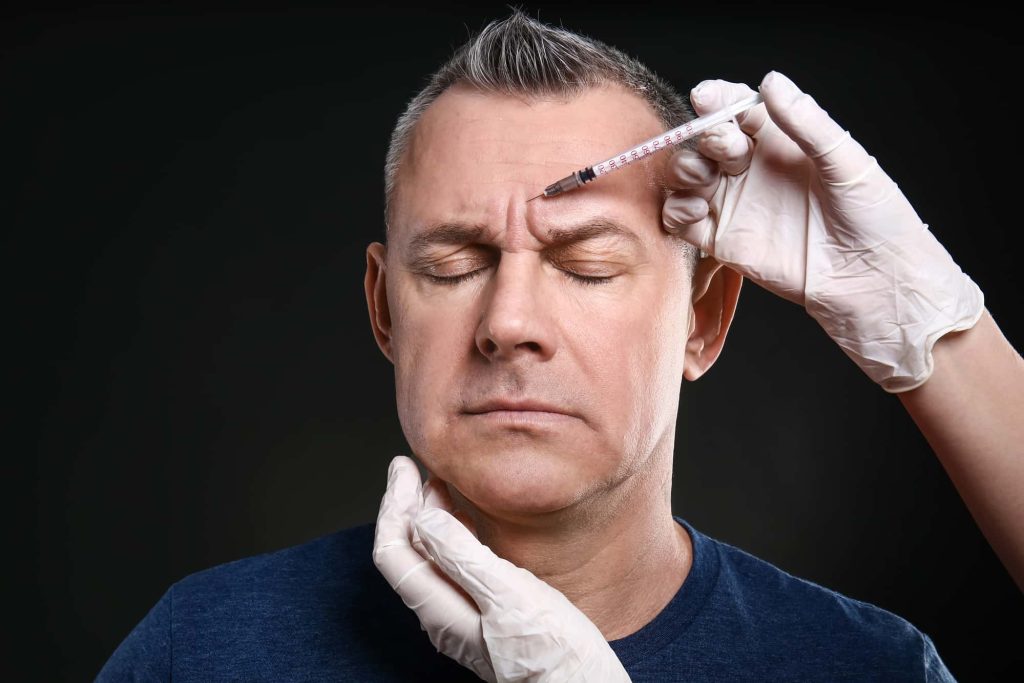Bell’s palsy is an uncomfortable condition that can appear suddenly and unexpectedly. This disorder was named after the Scottish anatomist Charles Bell, who described it in his 1821 paper. Botox is said to be the most effective treatment for this type of facial paralysis. In this article, we will explain what using Botox for Bell’s palsy entails.
What Is Botox?
Botox is an injectable, highly purified product derived from a toxin found in a bacterium called Clostridium botulinum. This toxin, botulinum, can help treat various health problems, but also for cosmetic reasons such as reducing wrinkles.
When it comes to medical reasons, Botox can be used to treat:
- Chronic migraine;
- An overactive bladder;
- Strabismus (misaligned eyes);
- Dystonia (excessive muscle contractions);
- Hyperhidrosis (excessive sweating);
- Benign essential blepharospasm (eye twitching).
Apart from these, there are some other conditions that Botox can be beneficial for, including Bell’s palsy. In the following sections, we will touch on what that condition is.
What Is Bell’s Palsy?
Bell’s palsy is a neurological condition that usually affects one side of a person’s face. This disorder is also referred to as:
- Antoni’s palsy
- Bell palsy
- Facial cranial nerve paralysis
- Facial nerve palsy
- Facial palsy
- Facial paralysis
- Idiopathic facial palsy
- Refrigeration palsy
This disorder causes the muscles to weaken, resulting in a droopy appearance of the face. The condition is transient for most patients but can be permanent in rare instances. To be more precise, 59 out of every 60 people recover from this condition.
However, as many as 30% of people do not experience 100% recovery, or it takes more than one month for their symptoms to resolve on their own. There is a chance of the condition reappearing. According to Warner et al. (2022), this may happen to 8% to 12% of people.
Sadly, idiopathic facial palsy can also be a catalyst for facial synkinesis or involuntary facial movements, which typically happen in conjunction with voluntary ones. For instance, for some people, it happens that their cheek lifts whenever they shut their eyes.
Due to the pain and discomfort, the patients feel, many seek some solution rather than waiting for the symptoms to go away on their own. You may wonder, does Botox help Bell’s palsy? That’s what we aim to answer in this article, right after explaining the symptoms and causes of this facial paralysis.
Bell’s Palsy Symptoms and Causes
Bell’s palsy is characterized by trouble smiling and making facial expressions. The patient will also most likely have a droopy eyelid or trouble closing one eye. The earliest symptoms are muscle weakness on one side of the face, fever, and pain behind one ear. Other symptoms include headaches and loss of taste.
While it is not known for sure what brings about facial paralysis, it is believed that one possible cause is inflammation incited by an infection of the facial nerve, which is referred to as the seventh cranial nerve. Other triggers may be a dormant viral infection, weak immunity, and damaged protective covering of the nerve fibers in the brain called myelin sheath.
Facial cranial nerve paralysis can affect anyone. However, it seems most common among individuals aged 15 to 40. Furthermore, people with diabetes, obesity, hypertension, and pregnant women are at the highest risk of developing this disorder.
How Botox Treats Facial Paralysis
Facial paralysis may resolve by itself, but this can take up to six months. That’s why treatment can be a viable solution. Botox for paralysis works by inhibiting the neurotransmitter that causes muscle contraction. This neurotransmitter is called acetylcholine.
Thus, a Botox injection helps loosen the tight muscles. This helps bring back the usual symmetry of the patient’s face, thus restoring their appearance to what it was before they were affected by the disorder. The injection is also effective at preventing involuntary facial movements induced by facial synkinesis.
Patient Selection
For a patient to be prescribed Botox to treat Bell’s palsy, the doctor ought to diagnose them first. The healthcare professional will make a preliminary diagnosis based on the visual appearance of the individual’s face.
Then, they may order electromyography to be performed to confirm their initial hypothesis. This is an electrophysiological test that can not only verify the diagnosis but may also help predict the outcome. It’s also worth noting that Botox for nerve damage in the face caused by Bell’s palsy is covered by insurance for eligible patients.
Procedure
Botox is one of the most effective solutions used to ease the symptoms of Bell’s palsy. This method is considered minimally invasive, as it involves injecting the solution into the affected area of the face, and the patient only feels minor discomfort. No anesthesia is needed, and the whole procedure only takes a few minutes.
Before starting the procedure, the patient should be evaluated to determine whether they are suitable for this kind of treatment or whether another method would be more beneficial. While it can be very effective, Botox is not for everyone, as there are some contraindications, which we will discuss later in the article.
As a medical professional, it’s crucial to know precisely where to inject Botox for Bell’s palsy to achieve effective results and avoid any complications. An adequate amount of this neurotoxic protein is also vital to a successful treatment.
Results and Aftercare
A patient with Bell’s palsy injected with botulinum toxin will typically start noticing results after 48 to 72 hours. They will notice the most improvement after one to two weeks. The positive effects can last up to four months, after which further treatment may be necessary.
There are some things for patients to remember after receiving their Botox injection to prevent any adverse effects and achieve better results. Thus, it is recommended to avoid:
- Facial or head massages for the first 24 hours after treatment;
- Saunas, hot tubs, and tanning beds for the first four hours after treatment, as exposure to heat can cause bruising;
- Lying down for the first three hours after treatment;
- Exercising for the first three hours after treatment.
As a doctor administering Botox for facial paralysis, you should give your patients detailed instructions on aftercare so that they can avoid any potential problems.
Potential Adverse Reactions and Contraindications
Even if the patient follows the doctor’s advice regarding aftercare, there’s still a chance they might experience some side effects. Side effects of Botox treatment for Bell’s palsy may include:
- Bruising, itching, or swelling around the injection site;
- A dry mouth;
- Tiredness;
- Headache;
- Nausea;
- Skin rash.
Some patients and professionals may ask themselves, can Botox cause Bell’s palsy? The answer to this question is: not really, no. Botox is considered a generally safe, problem-free injectable, and it is only through product mishandling by any inexperienced professional that problems similar to Bell’s palsy occur. Though, even then, the effect of a wrongly administered injection would be limited to the facial muscles and not the nerves, as is the case with this health condition. No matter what, to eliminate the risk of complications, it must only be administered by a qualified medical professional.
It should also be noted that pregnant women and those breastfeeding should avoid this type of treatment. Botulinum toxin injections are also not suitable for people allergic to some of their ingredients, patients with an infection around the injection site or neuromuscular disorders such as myasthenia gravis, and those who are taking aminoglycosides or muscle relaxants.
Conclusion
As you can see, Botox is a favorable option for people experiencing symptoms of Bell’s palsy. The patient may choose to wait for the condition to resolve on its own or try different treatment options. However, Botox is a safe and very effective solution worth considering. Nevertheless, it’s best for patients to consult with their doctor before making their final decision.
FAQ
Where do you inject Botox for Bell’s palsy?
Botox used to treat Bell’s palsy is injected in the affected area of the face. Our face has 43 muscles, so it’s of utmost importance to know where exactly to inject the product for the desired effect.
How long does Bell’s palsy last after Botox?
Following a Botox injection, the patient will still have Bell’s palsy symptoms for the first 48 to 72 hours. After that period, they will likely start to see the first improvements. The positive results are typically the most visible after one to two weeks.
What is the best treatment for Bell’s palsy?
While Bell’s palsy symptoms usually resolve on their own, this may take up to six months. In some cases, albeit quite rarely, the condition is permanent. That’s why there are treatment options to help patients dealing with this disorder. Some of the best treatment options for Bell’s palsy include Botox, steroid injections, physical therapy, and selective neurolysis. Using Botox for Bell’s palsy is quite a convenient method as the results show up quite quickly, and the treatment is generally safe and simple to administer.
References
Holland, N. J., & Bernstein, J. M. (2014). Bell’s Palsy. BMJ Clinical Evidence, 1204. https://www.ncbi.nlm.nih.gov/pmc/articles/PMC3980711/
Synkinesis. UNC School of Medicine. https://www.med.unc.edu/ent/facialnervecenter/conditions/synkinesis/
Warner MJ, Hutchison J, Varacallo M. Bell Palsy. National Library of Medicine. September 2022. https://www.ncbi.nlm.nih.gov/books/NBK482290/
Botox for Facial Paralysis. The Facial Paralysis Institute. https://www.facialparalysisinstitute.com/treatments/botox/





















